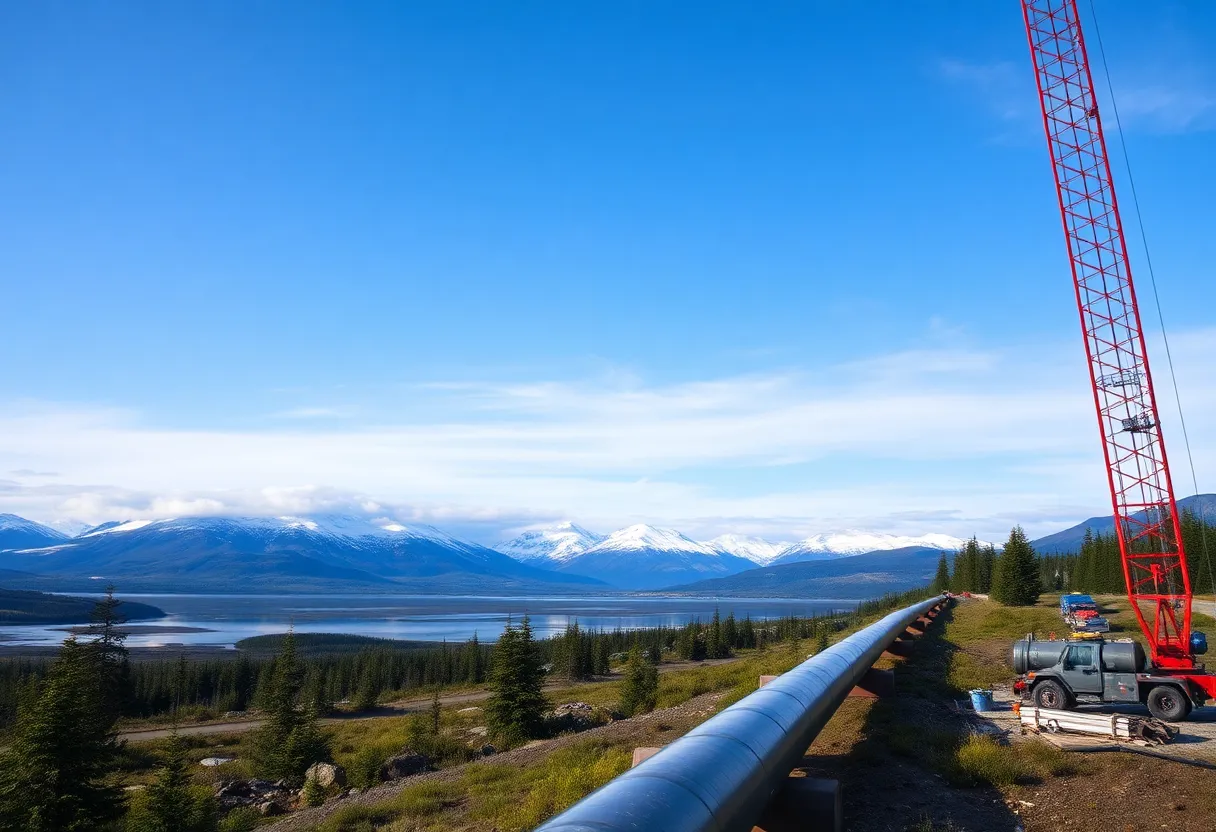News Summary
Glenfarne Alaska LNG has revealed intentions to begin construction on a natural gas pipeline by late 2026, aiming for operational status by mid-2029. The project is projected to transport 3.5 billion cubic feet of natural gas daily, following the existing Trans-Alaska Pipeline System. Despite challenges such as pending regulatory approvals and community concerns, state and federal support exists for the project, which seeks to enhance Alaska’s LNG export capacity amidst rising global energy demands.
Anchorage, Alaska – Glenfarne Alaska LNG has announced plans to initiate construction on its proposed pipeline in late 2026, targeting operational status by mid-2029. This timeline was confirmed following a meeting between Glenfarne Alaska LNG President Adam Prestidge and Japanese Consul Kiyohiko Hamada, which also included representatives from 8 Star Alaska, a subsidiary of the Alaska Gasline Development Corporation (AGDC).
The proposed pipeline aims to transport around 3.5 billion cubic feet of natural gas daily, primarily adhering to the route of the existing Trans-Alaska Pipeline System. This ambitious project is positioned to enhance Alaska’s capacity to export liquefied natural gas (LNG), which is particularly critical as global demand for energy sources continues to rise.
With the announcement indicating a proactive approach toward meeting future energy needs, Interior Secretary Doug Burgum noted the potential for construction to commence as soon as 2026. However, the project is currently navigating several complexities, including pending regulatory approvals, with three necessary permits still awaiting clearance.
Financial and Regulatory Challenges
While Glenfarne has set these optimistic timelines, the company has not yet disclosed the total cost of the project or its various funding sources. This secrecy raises concerns amidst a backdrop of fiscal scrutiny within the state. Alaska is currently grappling with budgetary constraints, as outlined by Governor Mike Dunleavy’s recent vetoes and cuts totaling over $100 million from the state budget, largely owing to dwindling oil revenues.
The construction timeline has incited discussions among members of the Alaska Gasline Caucus, where officials from the company have suggested a need for early construction phases by mid-2026. Despite these discussions, substantial skepticism remains, particularly from some community members and environmental advocates who worry about the potential impacts on local wildlife and traditional lands.
State and Federal Support
At the same time, support for the project exists at both state and federal levels. Previous reassurances came from President Donald Trump, who had consistently advocated for enhancing Alaska’s LNG capabilities through a series of executive orders. Current discussions indicate that both local and national interests are weighing the benefits against environmental repercussions.
Historical Context
Alaska has a long history of attempting to develop its natural gas potential. Over the past 25 years, nearly $1 billion has been invested in gas line efforts, with past proposals becoming mired in financial obstacles and regulatory setbacks. Recently, Glenfarne acquired a 75% stake in the project from AGDC, promising renewed interest and commitment to overcoming previous failures.
Despite the hurdles, the prospect of the pipeline has been revived at a time when natural gas prices are volatile, and competition in the energy market is intensifying. Discussions within the industry center on balancing investment fait accompli against ongoing financial challenges, particularly as public and private investors remain wary of fluctuating oil prices.
Looking Ahead
As Glenfarne prepares to move forward with the regulatory process and construction, it must also address community concerns and satisfy environmental standards that are crucial for long-term sustainability. The coming months will be critical as stakeholders assess the potential ramifications of pipeline development against the backdrop of Alaska’s complex energy landscape.
The future of the Glenfarne Alaska LNG pipeline remains precarious but filled with opportunity, as the state and industry officials work collaboratively to navigate the intricacies of this significant infrastructure project.
Deeper Dive: News & Info About This Topic
HERE Resources
Additional Resources
- Alaska News Source
- Wikipedia: Natural Gas in Alaska
- Anchorage Daily News
- Google Search: Alaska LNG Pipeline
- Rolling Stone
- Google Scholar: Alaska LNG Project
- New York Times
- Encyclopedia Britannica: Alaska LNG
- Reuters
- Google News: Alaska LNG Pipeline
Author: STAFF HERE INDIANAPOLIS WRITER
The INDIANAPOLIS STAFF WRITER represents the experienced team at HEREIndianapolis.com, your go-to source for actionable local news and information in Indianapolis, Marion County, and beyond. Specializing in "news you can use," we cover essential topics like product reviews for personal and business needs, local business directories, politics, real estate trends, neighborhood insights, and state news affecting the area—with deep expertise drawn from years of dedicated reporting and strong community input, including local press releases and business updates. We deliver top reporting on high-value events such as the Indianapolis 500, Indy Jazz Fest, and the Indiana State Fair. Our coverage extends to key organizations like the Indy Chamber and Visit Indy, plus leading businesses in motorsports and healthcare that power the local economy such as Indianapolis Motor Speedway and IU Health. As part of the broader HERE network, we provide comprehensive, credible insights into Indiana's dynamic landscape.





